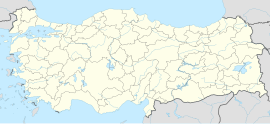Yarbaşı, İdil
Yarbaşı | |
|---|---|
| Coordinates: 37°23′28″N 41°51′58″E / 37.391°N 41.866°E | |
| Country | Turkey |
| Province | Şırnak |
| District | İdil |
| Population (2021)[1] | 1,182 |
| Time zone | UTC+3 (TRT) |
Yarbaşı (Arabic: إِسفِس; Kurdish: Hespîst;[2] Syriac: ܐܣܦܣ, romanized: Isfes)[3][a] is a village in the İdil District of Şırnak Province in Turkey.[5] The village is populated by Kurds of the Omerkan tribe and had a population of 1,182 in 2021.[1][2] It is located in the historic region of Beth Zabday.[6]
There was a church of Mor Dodo which purported to possess relics of him.[7]
History
[edit]Isfes (today called Yarbaşı) is identified with Hiaspis mentioned by the Roman historian Ammianus Marcellinus in Res gestae in the 4th century AD along the frontier with the Sasanian Empire.[8] It was noted as the location of the defection of the protector domesticus Antoninus to the Sasanian Empire.[9] The Syriac Orthodox maphrian Basil Solomon took refuge at Isfes after having fled Mosul in 1514 and remained there until his death in 1518.[10] An attack by Muhammad Pasha of Rawanduz on Isfes resulted in the death of 80 men, including a priest and a notable, and the enslavement of a number of women and children in early 1834.[11] The village was part of the Syriac Orthodox diocese of Cizre in c. 1870.[12]
By the Sayfo, Isfes was inhabited by 300 Assyrian families and had five priests.[13] On 6 June 1915, the village withstood an attack by the Kurdish Ömerkan, ‘Alikan, and Dörekan tribes and the villagers were fired upon by an Al-Khamsin militia detachment that had arrived and promised to protect them.[13] The village's notables were killed.[14] After three days of fighting, the villagers were able to flee to Azakh after the priest ‘Abdallahad Jebbo managed to bribe the detachment commander Ilyas Chelebi and Isfes was subsequently looted and burned as they fled.[15]
In 1926, the village was disarmed under pressure from the Turkish government and then plundered whilst the men were killed in forced deportations to Diyarbakir and Cizre and the women and children were left at the mercy of the Turkish soldiers.[16] The Assyrian population of Isfes began to emigrate to Al-Malikiyah in Syria from 1960 onwards and eventually the last Assyrian family left in 1980.[17] The church of Mor Dodo was converted into a house and a barn.[18]
References
[edit]Notes
Citations
- ^ a b "31 ARALIK 2021 TARİHLİ ADRESE DAYALI NÜFUS KAYIT SİSTEMİ (ADNKS) SONUÇLARI" (XLS). TÜİK (in Turkish). Retrieved 16 December 2022.
- ^ a b Baz (2016), p. 133.
- ^ Carlson, Thomas A. (14 January 2014). "Isfis - ܐܣܦܣ". The Syriac Gazetteer. Retrieved 20 May 2023.
- ^ Palmer (1990), p. 264; Courtois (2013), p. 147; Gaunt (2006), p. 220; Courtois (2004), p. 192.
- ^ "Türkiye Mülki İdare Bölümleri Envanteri". T.C. İçişleri Bakanlığı (in Turkish). Retrieved 19 December 2022.
- ^ Barsoum (2003), p. 554.
- ^ Palmer (1990), pp. 31–32.
- ^ Palmer (1990), p. 4.
- ^ Dignas & Winter (2007), p. 252.
- ^ Barsoum (2009), pp. 163–164.
- ^ Barsoum (2008), pp. 128–129.
- ^ Brock (2021), p. 156.
- ^ a b Gaunt (2006), p. 220.
- ^ Courtois (2004), p. 192.
- ^ Gaunt (2006), pp. 220, 277–278; Sato (2001), p. 54.
- ^ Yacoub (2016), p. 192.
- ^ Courtois (2013), p. 147.
- ^ Sinclair (1989), p. 330.
Bibliography
[edit]- Barsoum, Aphrem (2003). The Scattered Pearls: A History of Syriac Literature and Sciences. Translated by Matti Moosa (2nd ed.). Gorgias Press. Retrieved 14 July 2020.
- Barsoum, Aphrem (2008). The History of Tur Abdin. Translated by Matti Moosa. Gorgias Press. Retrieved 1 April 2021.
- Barsoum, Aphrem (2009). The Collected Historical Essays of Aphram I Barsoum. Vol. 1. Translated by Matti Moosa. Gorgias Press. Retrieved 26 June 2021.
- Baz, Ibrahim (2016). Şırnak aşiretleri ve kültürü (in Turkish). p. 133. ISBN 9786058849631.
- Brock, Sebastian (2021). "The Syrian Orthodox Church in the twentieth century". Eastern Christianity, Theological Reflection on Religion, Culture, and Politics in the Holy Land and Christian Encounter with Islam and the Muslim World (PDF). Living Stones of the Holy Land Trust. pp. 155–181. Retrieved 12 August 2022.
- Courtois, Sébastien de (2004). The Forgotten Genocide: Eastern Christians, The Last Arameans. Translated by Vincent Aurora. Gorgias Press. Retrieved 20 November 2024.
- Courtois, Sébastien de (2013). "Tur Abdin : Réflexions sur l'état présent descommunautés syriaques du Sud-Est de la Turquie,mémoire, exils, retours". Cahier du Gremmamo (in French). 21: 113–150.
- Dignas, Beate; Winter, Engelbert (2007). Rome and Persia in Late Antiquity: Neighbours and Rivals. Cambridge University Press.
- Gaunt, David (2006). Massacres, Resistance, Protectors: Muslim-Christian Relations in Eastern Anatolia during World War I. Gorgias Press. Retrieved 21 May 2023.
- Palmer, Andrew (1990). Monk and Mason on the Tigris Frontier: The Early History of Tur Abdin. Cambridge University Press. Retrieved 15 July 2020.
- Sato, Noriko (2001). Memory and Social Identity among Syrian Orthodox Christians (PDF). Retrieved 27 December 2019.
- Sinclair, T. A. (1989). Eastern Turkey: An Architectural and Archaeological Survey. Vol. III. London: The Pindar Press.
- Yacoub, Joseph (2016). Year of the Sword: The Assyrian Christian Genocide, A History. Translated by James Ferguson. Oxford University Press. Retrieved 21 November 2024.

